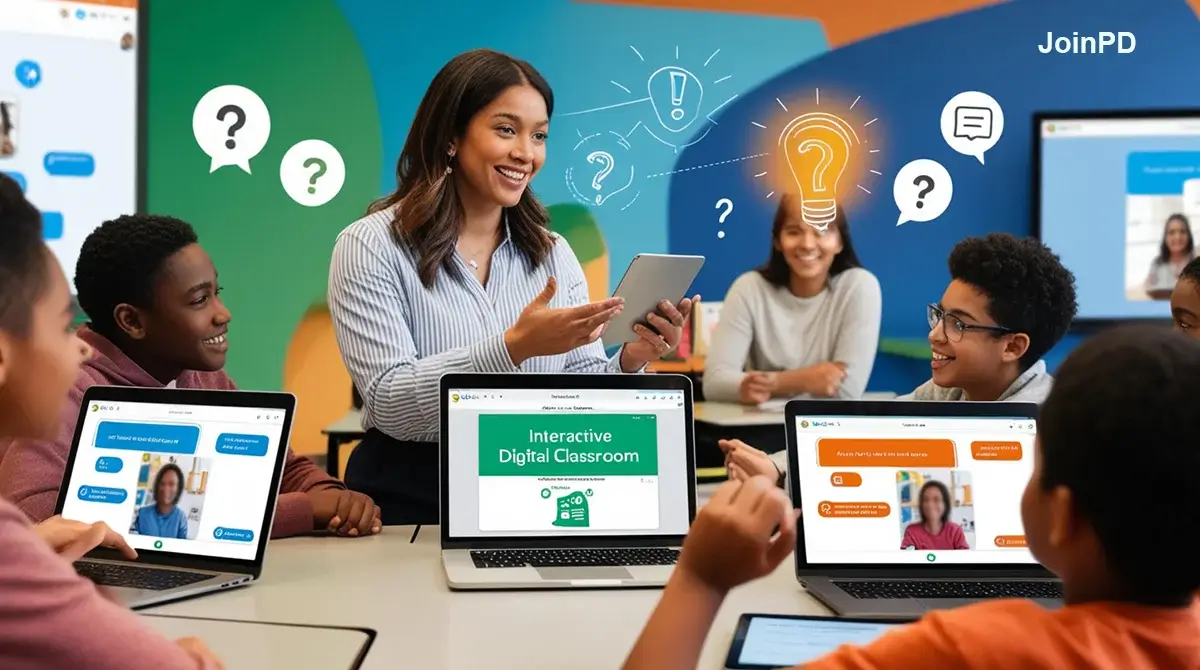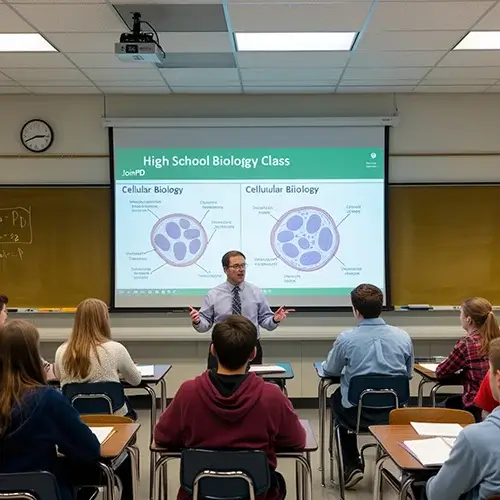Revolutionizing Classroom Collaboration
Introduction
In today’s rapidly evolving educational landscape, the integration of technology into the classroom has become a vital necessity. Tools that foster collaboration and engagement among students and educators are crucial for enhancing the learning experience. One such innovative platform that has gained significant traction in recent years is JoinPD. Designed to streamline classroom interaction and presentation, JoinPD is transforming the way teachers deliver content and how students engage with it. This article explains the features, benefits and overall impact of JoinPD in educational settings, exploring how it enhances learning and facilitates communication.
JoinPD or Join Presentation, is an interactive web-based platform that allows educators to create and share engaging presentations with their students in real-time. It is primarily used in classrooms but can also be applied in various educational settings, such as workshops, training sessions and online courses. The platform was developed to address the challenges educators face when delivering presentations, including disengaged students, difficulty in assessing comprehension and the need for immediate feedback.
By providing a space for interactive learning, JoinPD fosters a collaborative environment where students can participate actively, ask questions and provide feedback. This interactivity not only increases engagement but also enhances understanding and retention of the material being presented.
Key Features
This table summarizes the core functionalities that make JoinPD a valuable tool for educators and students.
| Feature | Description |
| Real-Time Collaboration | Allows teachers to share presentations instantly with students, fostering real-time participation and interaction. |
| Interactive Questioning | Includes quizzes, polls and open-ended questions to engage students and assess their understanding in real-time. |
| Anonymous Feedback | Enables students to submit feedback or ask questions anonymously, promoting open participation without fear of judgment. |
| Ease of Use | Designed with a user-friendly interface, making it simple for both educators and students to navigate and utilize. |
| Cross-Platform Accessibility | Accessible on any device with an internet connection, including laptops, tablets and smartphones. |
| Integration with Other Tools | Works seamlessly with educational platforms like Google Classroom, Microsoft Teams and other LMS systems. |
JoinPD comes equipped with a multitude of features designed to facilitate effective teaching and learning:
1. Real-Time Collaboration
One of the standout features of JoinPD is its ability to promote real-time collaboration. Educators can create a presentation and share it with students instantly. Students can join the presentation by entering a unique code, which provides them access to the content being shared. This instant connectivity allows students to engage with the material in real-time, making it easier for them to follow along and participate actively.
2. Interactive Questioning
JoinPD includes a variety of interactive questioning tools that enable teachers to assess students’ understanding during the presentation. Educators can create polls, quizzes and open-ended questions that students can respond to directly through their devices. This feature not only encourages participation but also provides immediate feedback to educators regarding student comprehension.
3. Anonymous Feedback
One of the challenges educators face is encouraging students to voice their opinions and questions. JoinPD addresses this issue by allowing students to provide feedback anonymously. This anonymity encourages more students to participate and share their thoughts without the fear of judgment. Educators can gauge the mood of the classroom and adjust their teaching strategies accordingly.
4. Accessibility and Ease of Use
JoinPD is designed to be user-friendly, ensuring that both educators and students can navigate the platform with ease. The intuitive interface allows teachers to set up presentations quickly and effectively, even if they are not tech-savvy. Additionally, as a web-based platform, JoinPD is accessible from any device with internet connectivity, whether it be a laptop, tablet or smart phone.
5. Integration with Other Tools
JoinPD seamlessly integrates with various educational tools and platforms, enhancing its functionality. For instance, it can be used alongside Google Classroom, Microsoft Teams, and other learning management systems (LMS). This integration allows for a smoother workflow, enabling educators to manage their presentations and student engagement more effectively.
Benefits of Using JoinPD
The implementation of JoinPD in educational settings offers numerous benefits for both educators and students:
1. Increased Engagement
With its interactive features, JoinPD significantly increases student engagement during presentations. Traditional lecture formats often lead to passive learning, where students may become disinterested or distracted. JoinPD transforms this dynamic by encouraging active participation, allowing students to engage with the content and with each other.
2. Improved Understanding and Retention
Active participation and collaboration lead to better comprehension and retention of information. By involving students in the learning process through quizzes and interactive discussions, educators can reinforce key concepts and ensure that students grasp the material being presented.
3. Instant Feedback
JoinPD allows educators to receive immediate feedback from their students through polls and questions. This real-time assessment helps teachers identify areas where students may be struggling and adjust their instruction accordingly. By understanding the level of comprehension in the classroom, educators can provide targeted support to students who need it most.
4. Enhanced Communication
JoinPD fosters a collaborative environment where communication flows freely between educators and students. The platform’s interactive features facilitate discussions and encourage students to voice their questions and opinions. This open communication creates a supportive learning atmosphere, making students feel valued and heard.
5. Flexibility in Teaching
JoinPD’s adaptability makes it a versatile tool for educators. It can be used in various teaching scenarios, whether in-person, hybrid or fully online. This flexibility allows teachers to cater to different learning environments and student needs, ensuring that all students have access to quality education.
Case Studies
To better understand the impact of JoinPD in real educational settings, it’s helpful to examine a few case studies that illustrate its effectiveness.
Case Study 1
In a high school biology class, a teacher implemented JoinPD to enhance student engagement during a unit on cellular biology. The teacher created a presentation that included interactive quizzes and polls about the various cell structures. By utilizing JoinPD, the teacher noticed a marked increase in participation, with 90% of students responding to polls compared to previous lessons where only 50% participated. The real-time feedback allowed the teacher to identify misconceptions about certain cell functions and address them immediately, leading to improved understanding among students.
Case Study 2
In a university-level online course, an instructor used JoinPD to facilitate discussions during live lectures. The instructor integrated open-ended questions that prompted students to share their thoughts on complex topics. The anonymity feature encouraged more students to participate, resulting in deeper discussions and a more vibrant online classroom environment. The instructor reported that student engagement significantly increased, with attendance and participation rates reaching an all-time high.
Case Study 3
During a series of professional development workshops for teachers, facilitators employed JoinPD to gather feedback from attendees. By using polls and anonymous surveys, the facilitators were able to gauge the effectiveness of their presentations and adjust their content on the fly based on participant feedback. This responsive approach led to more effective workshops, with participants expressing greater satisfaction and engagement.
Challenges and Considerations
While JoinPD offers numerous advantages, it is essential to consider some potential challenges and considerations for its implementation:
1. Internet Connectivity
Since JoinPD is a web-based platform, reliable internet access is crucial for its successful use. In areas with limited connectivity, educators may face challenges in utilizing the platform effectively. Schools should ensure that students have access to the necessary technology and reliable internet to participate fully.
2. Digital Literacy
Educators and students must possess a certain level of digital literacy to navigate the platform effectively. Training and support may be necessary to ensure that all users can utilize JoinPD to its fullest potential.
3. Over-Reliance on Technology
While technology can enhance learning, over-reliance on tools like JoinPD may detract from traditional teaching methods that also hold value. Educators should strive for a balanced approach that combines technology with effective pedagogical practices.
Conclusion
JoinPD represents a significant advancement in educational technology, providing educators and students with a powerful tool for enhancing classroom collaboration and engagement. Its interactive features, real-time feedback, and ease of use make it an invaluable resource for modern educators looking to create dynamic learning environments. By fostering collaboration and communication, JoinPD not only transforms the way presentations are delivered but also enriches the overall educational experience. As technology continues to evolve, platforms like JoinPD will play a crucial role in shaping the future of education, paving the way for more engaging and effective teaching practices.
In summary, the adoption of JoinPD in educational settings can lead to improved student outcomes, enhanced engagement and a more collaborative classroom environment, making it a vital tool for educators in the 21st century.





